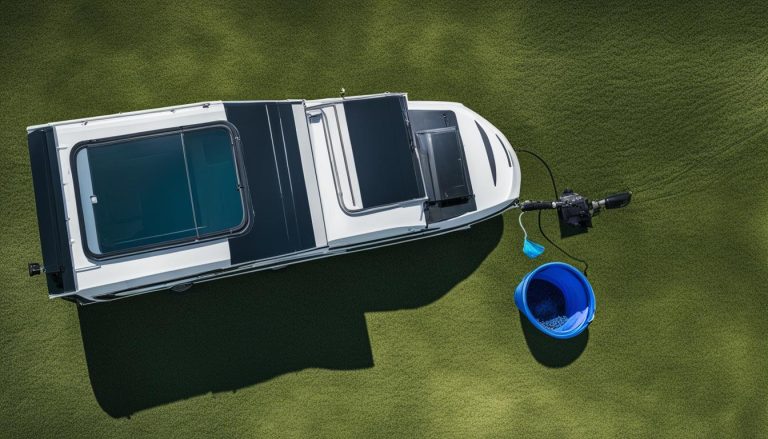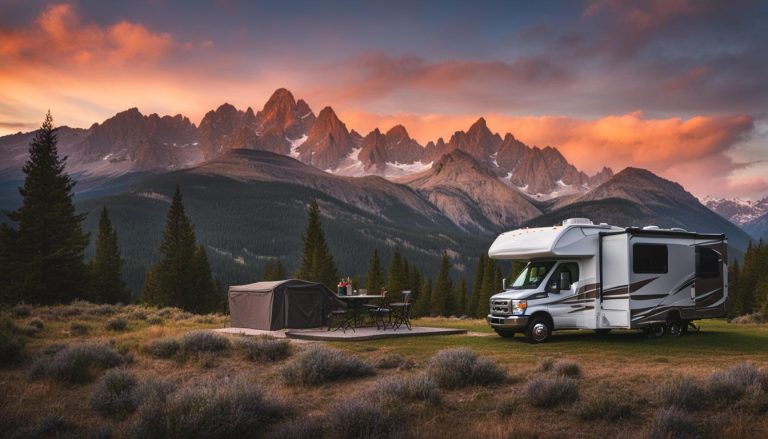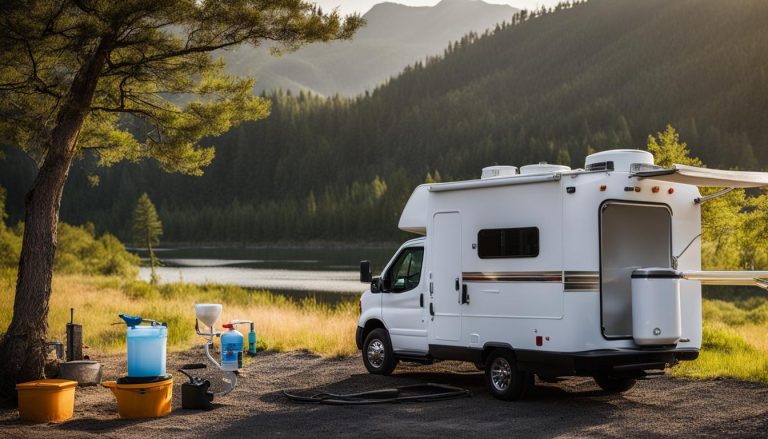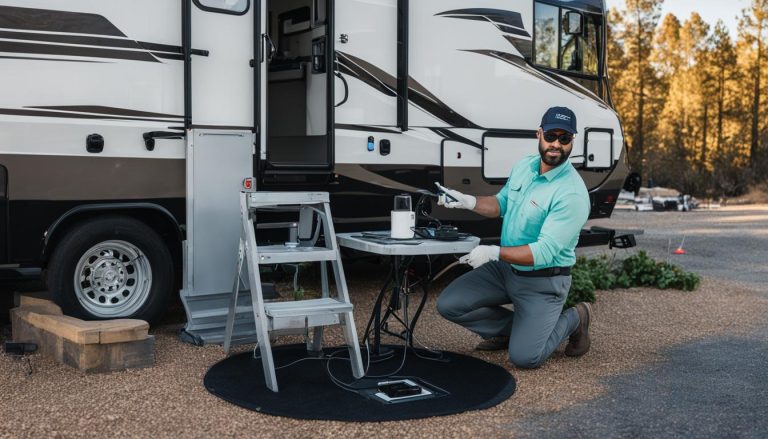Van to RV Conversion: Your DIY Guide
gorvlifestyle.com and its partners may earn a commission if you purchase a product through one of our links
Converting a van into an RV is an exciting DIY project that allows you to create your own personalized home on wheels. Whether you’re a weekend warrior or a full-time traveler, transforming a van into an RV offers the freedom to explore the open road while enjoying the comforts of home.
This comprehensive guide will take you through all the steps necessary to successfully convert your van to an RV. From choosing the right vehicle for your needs to insulating the walls and installing a bed, we’ll provide you with all the information you need to embark on your van to RV conversion journey. Get ready to unleash your creativity and make your dream of van life a reality!
Key Takeaways
- Converting a van to an RV allows you to create a personalized home on wheels.
- Choosing the right vehicle is crucial for a successful conversion.
- Stripping and preparing the van is the first step in the conversion process.
- Insulating the walls and floor is essential for comfort and energy efficiency.
- Designing the layout and installing ventilation and electricity are important aspects of the conversion.
Choosing the Right Van for Your Conversion
The first step in converting a van to an RV is selecting the perfect vehicle that suits your needs and preferences. There are several types and models of vans to consider, each offering its own advantages and drawbacks. Whether you’re dreaming of a modern, versatile van or prefer the charm of an old school classic, there’s a van out there that’s perfect for your van life adventure.
Cargo vans are popular choices for conversion projects as they provide a blank canvas for customization. Their spacious interiors offer ample space to create the layout and design of your dreams. When it comes to cargo van options, you have the best of both worlds.
Modern Vans: Mercedes Sprinter, Ford Transit, Dodge Ram Promaster, Nissan NV
| Modern Vans | Old School Vans |
|---|---|
| Mercedes Sprinter | Chevy Express |
| Ford Transit | GMC Savanna |
| Dodge Ram Promaster | Ford Econoline |
| Nissan NV | Dodge Ram Van |
Old School Vans: Chevy Express, GMC Savanna, Ford Econoline, Dodge Ram Van
When it comes to old school vans, they offer reliability and affordability. These vans have stood the test of time and are still cherished by van life enthusiasts. Consider your budget and the level of customization you desire when choosing an old school van for your conversion project.
Lastly, if you’re looking to fully embrace the van life culture, you may want to explore Volkswagen Westfalia campers. These iconic vehicles are beloved for their nostalgia, unique design, and compact yet functional interiors. They have been the go-to choice for adventurers for decades.
Take your time, do your research, and consider your needs, budget, and lifestyle before making a decision. Choosing the right van is a crucial step that will set the foundation for your future RV conversion.
Stripping and Preparing the Van
Before embarking on your van to RV conversion journey, it’s crucial to strip and prepare the van, creating a clean canvas for your project. This involves removing the existing interior components and giving your van a thorough cleaning.
First, start by stripping the van of any unnecessary parts. This includes seats, cabinetry, and flooring that may hinder your conversion process. By removing these interior components, you’ll have a blank slate to design and customize your RV according to your needs and preferences.
Once you’ve stripped the van, it’s time to give it a deep clean. Cleaning the van thoroughly ensures that your new living space will be free from dirt, grime, and odors. Scrub the walls, ceiling, and floor to remove any dirt or stains. Pay close attention to hard-to-reach areas, such as corners and crevices, as these areas tend to accumulate dust and debris.
Remember to use appropriate cleaning products and techniques for different surfaces. For example, use mild soap and water for the walls and a suitable floor cleaner for the flooring material. Additionally, don’t forget to clean the windows both inside and out to allow natural light to fill your future home on wheels.
Stripping and cleaning the van may require some time and effort, but it lays the foundation for a successful van to RV conversion. With a stripped and clean van, you now have a blank canvas to turn your vision into reality.
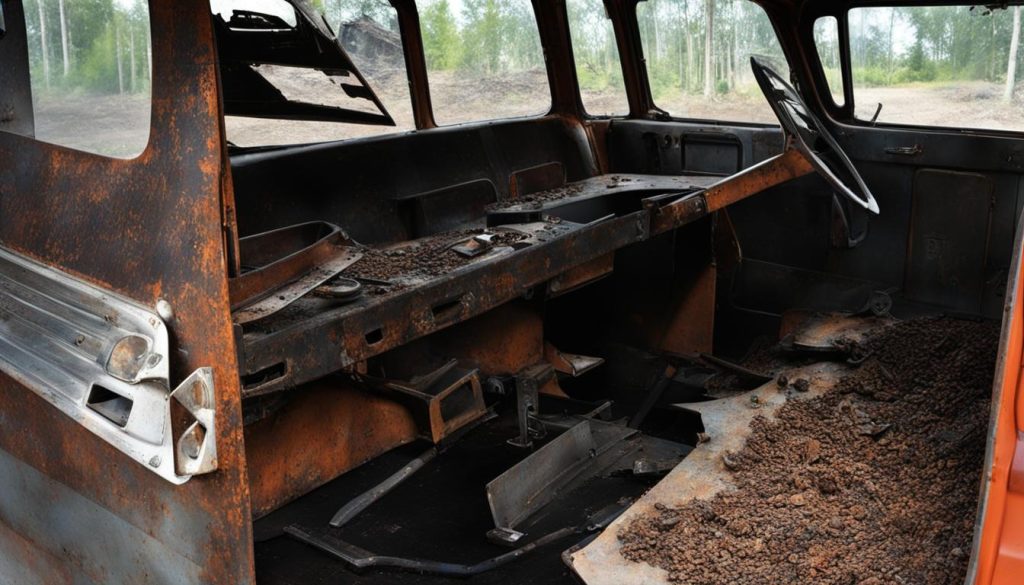
Why is Stripping and Cleaning Important?
Creating a clean and blank canvas is essential for a successful van conversion project. Stripping the van removes unnecessary components, allowing you to customize the space to your liking. Cleaning the van ensures a fresh and inviting living environment, free from dirt and odors. A well-prepared van sets the stage for a comfortable and functional RV lifestyle.
Insulating the Walls and Floor
Insulating the walls and floor of your van is one of the most important steps in your van to RV conversion. Proper insulation not only enhances comfort but also improves energy efficiency. With the right insulating materials, you can create a cozy and insulated living space inside your van.
When it comes to van insulation, there are various options to choose from. Two popular choices are Xtrem insulation and Thinsulate. Xtrem insulation is known for its excellent thermal insulation properties, keeping your van cool in hot weather and warm in cold weather. Thinsulate, on the other hand, provides both thermal and sound insulation, reducing noise from the road and ensuring a peaceful interior environment.
Whether you opt for Xtrem insulation or Thinsulate, the installation process is relatively straightforward. Here are the steps to insulate your van:
- Prepare the walls and floor: Before installing the insulation, make sure the walls and floor are clean and free from any debris.
- Measure and cut the insulation: Measure the dimensions of your van’s walls and floor, and cut the insulation material accordingly. Make sure to leave a small gap for expansion.
- Attach the insulation: Use adhesive or insulation tape to attach the insulation to the walls and floor. Ensure there are no gaps or overlaps.
- Seal the edges: Seal the edges of the insulation with foam or adhesive to prevent air leakage.
Properly insulating your van will not only keep the interior temperatures comfortable but also reduce the need for excessive heating or cooling, saving you energy and money in the long run.
Insulating the walls and floor of your van is essential for comfort and energy efficiency.
So, don’t overlook this vital step in your van to RV conversion. Take the time to insulate your van properly, and you’ll create a cozy and thermally efficient home on wheels.
Key Takeaways
- Insulating the walls and floor is crucial for comfort and energy efficiency in your van to RV conversion.
- Xtrem insulation and Thinsulate are popular choices for van insulation, providing thermal and sound insulation.
- To insulate your van, clean the walls and floor, measure and cut the insulation, attach it using adhesive or insulation tape, and seal the edges.
- Proper insulation regulates temperature, reduces noise, and saves energy in the long run.
Now that your van is properly insulated, it’s time to move on to the next step: designing the layout of your RV.
Designing the Layout
Designing the layout of your RV is a crucial step in your van to RV conversion. It’s the opportunity to create a space that meets your specific needs and enhances your comfort on the road. When planning the layout, take into consideration the placement of the bed and couch, the kitchen setup, and storage options.
Start by assessing the available space in your van and taking accurate measurements. This will help you determine the dimensions and proportions of the different components. Consider your lifestyle and daily activities to ensure the layout is practical and functional.
Bed and Couch Arrangement:
- Choose a bed configuration that suits your sleeping preferences and space limitations. Popular options include fixed beds, convertible sofa beds, and hammock-style beds that can be rolled up during the day.
- Place the bed in a location that maximizes space and allows for easy access. You may consider positioning it lengthwise or sideways, depending on the van’s dimensions.
- If you plan to have a couch or seating area, think about its placement in relation to the bed. Ensure there is enough room for comfortable seating and movement within the living area.
Kitchen and Storage Planning:
- Create an efficient kitchen setup by considering the essential appliances you need, such as a stove, sink, and refrigerator. Optimize counter space by incorporating foldable or slide-out surfaces.
- Plan storage solutions that make the most of the available space. Consider installing overhead cabinets, under-bed storage, and pull-out drawers. Utilize vertical space by adding shelving units or hooks.
- Think about the items you’ll need to store, such as kitchenware, clothing, and recreational equipment. Organize your storage compartments to keep everything easily accessible and secure during travel.
| Layout Considerations | Benefits |
|---|---|
| Open floor plan | Maximizes space and creates a sense of openness |
| Multi-functional furniture | Optimizes space during the day and provides versatile living arrangements |
| Strategic placement of appliances | Facilitates easy access and efficient use of kitchen and bathroom facilities |
| Well-designed storage solutions | Keeps belongings organized and minimizes clutter |
By carefully considering the van layout design, bed and couch arrangement, and kitchen and storage planning, you can create a functional and comfortable living space in your converted RV. Remember to prioritize your individual needs and preferences as you design the layout, ensuring a personalized space that enhances your vanlife experience.
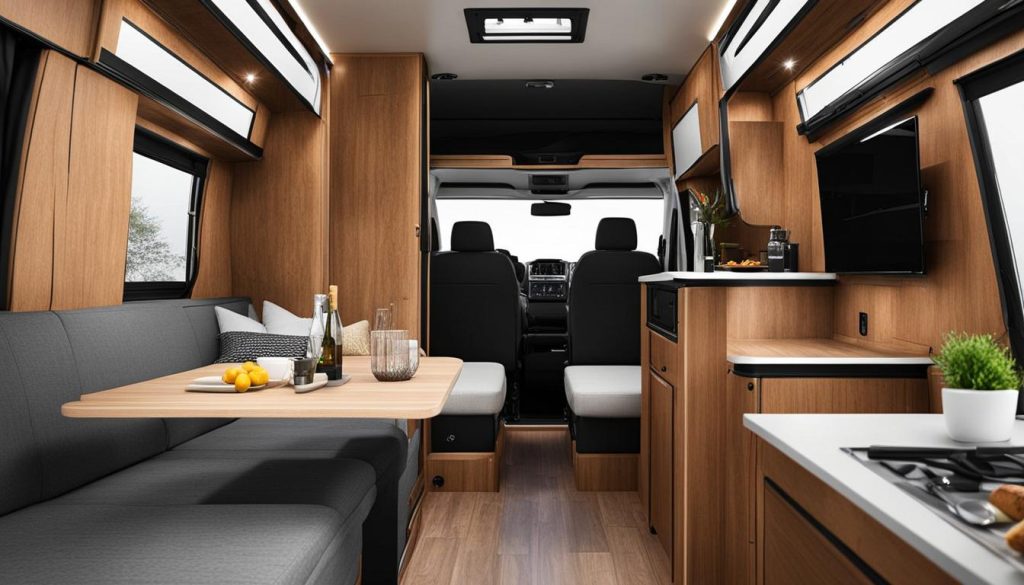
Installing Ventilation and Electricity
Proper ventilation and a reliable electrical system are crucial components of a functional and comfortable RV. Without proper ventilation, the air inside the van can become stagnant and unpleasant. Installing roof vents and fans allows for fresh air circulation, keeping the interior airy and reducing the risk of condensation buildup. By ensuring proper ventilation, you can create a healthier living environment inside your RV.
Next, let’s talk about the electrical system. An efficient RV electrical system powers appliances, lights, and allows you to charge your devices. It’s essential to set up a system that meets your power needs and ensures reliable energy supply. Consider using solar power installation to harness the sun’s energy and reduce your reliance on external power sources. Solar panels are a sustainable and cost-effective option, providing clean energy and quiet operation.
When installing the electrical system, it’s essential to follow safety protocols and properly insulate the wiring. This ensures the longevity and safety of the system, preventing potential electrical hazards. Be sure to consult a professional or do thorough research to ensure your electrical setup complies with safety standards.
Overall, proper ventilation and a functional electrical system are essential for a comfortable and sustainable RV experience. By installing vents, fans, and solar panels, you can create a well-ventilated and energy-efficient living space on the road.
Key Points:
- Install roof vents and fans for fresh air circulation and to prevent condensation buildup.
- Set up an efficient electrical system to power appliances, lights, and devices.
- Consider solar power installation to reduce reliance on external power sources.
- Properly insulate wiring and ensure the electrical system meets safety standards.
Constructing the Bed and Couch
Creating a comfortable sleeping and seating area is essential for your van to RV conversion. The construction of a sturdy and functional bed is crucial to maximize space and ensure a good night’s sleep. Consider using multi-functional furniture, such as a convertible sofa bed, to optimize space during the day. This allows you to have a comfortable seating area that can easily transform into a bed when needed.
When constructing the bed, focus on utilizing the available space efficiently. Consider installing a platform bed with built-in storage compartments underneath. This provides additional storage space for your belongings, helping to keep the living area organized. Make sure to use durable materials that can withstand the rigors of road travel, ensuring a long-lasting and comfortable sleeping surface.
For the couch installation, choose a design that complements the overall aesthetic of your RV. Opt for a couch that can be easily secured to prevent movement during travel. Consider a modular or sectional couch that can be rearranged to fit different seating configurations and accommodate more guests.
When selecting upholstery, prioritize comfort and durability. Look for fabrics that are easy to clean, stain-resistant, and can withstand frequent use. Additionally, consider the color and design of the upholstery to create a cohesive and inviting interior.
Benefits of Multi-functional Furniture
“Having multi-functional furniture in your RV can significantly enhance your living space. It allows you to make the most of limited square footage by serving multiple purposes. Not only does it save space, but it also adds versatility and functionality to your van to RV conversion.”
| Benefits of Multi-functional Furniture | Examples |
|---|---|
| Space optimization | Convertible sofa beds with storage compartments |
| Flexibility | Modular or sectional couches that can be rearranged |
| Additional seating | Ottomans or benches with hidden storage |
| Creative use of space | Foldable dining tables or collapsible workstations |
Investing in multi-functional furniture not only enhances the aesthetics and functionality of your RV but also helps to optimize space and create a more comfortable living environment.
Building the Kitchen and Storage Space
The kitchen and storage space are crucial elements of your RV conversion. When constructing your van’s kitchen, focus on creating a functional and compact area that meets your cooking needs. Consider installing a sink, stove, and ample storage for cookware and food supplies.
To optimize space and keep your belongings organized, incorporate smart storage solutions such as cabinets, shelves, and drawers. Utilizing these storage options will help maximize the available space and ensure everything has its designated place. Additionally, consider using space-saving techniques and accessories to make the most of the limited space inside your van.
Personalization is key when building your kitchen and storage area. Tailor the design to match your specific needs and preferences. Add touches that reflect your personality and make the space comfortable and inviting. A well-designed kitchen and storage space will enhance your overall van life experience, making you feel at home no matter where the road takes you.
FAQ
How do I choose the right van for my conversion?
Consider factors such as your needs, budget, and preferences. Popular options include cargo vans, modern vans like the Mercedes Sprinter or Ford Transit, old school vans like the Chevy Express, GMC Savanna, or Volkswagen Westfalia campers.
What steps are involved in stripping and preparing the van?
You will need to remove existing interior components such as seats, cabinetry, and flooring. Cleaning the van thoroughly is also important to create a clean canvas for the conversion.
What type of insulation should I use for the walls and floor?
There are various insulation materials available, such as Xtrem insulation and Thinsulate, which provide thermal and sound insulation. Proper insulation helps regulate temperature and reduces noise.
How should I design the layout of my RV?
Consider factors such as the placement of the bed, couch, kitchen setup, and storage options. The layout should be functional, maximizing space and providing comfort.
How do I install ventilation and set up electricity in my RV?
Install roof vents and fans for fresh air circulation and consider solar panels for renewable energy. Set up an electrical system to power appliances, lights, and charge devices.
How can I construct a comfortable bed and seating area?
Build a sturdy and functional bed that maximizes space. Consider using multi-functional furniture like a convertible sofa bed. Choose comfortable and durable materials for upholstery and bedding.
How can I build a kitchen and storage space in my RV?
Create a functional kitchen area with a sink, stove, and storage for cookware and food. Utilize storage solutions like cabinets, shelves, and drawers to keep belongings organized and maximize space.


